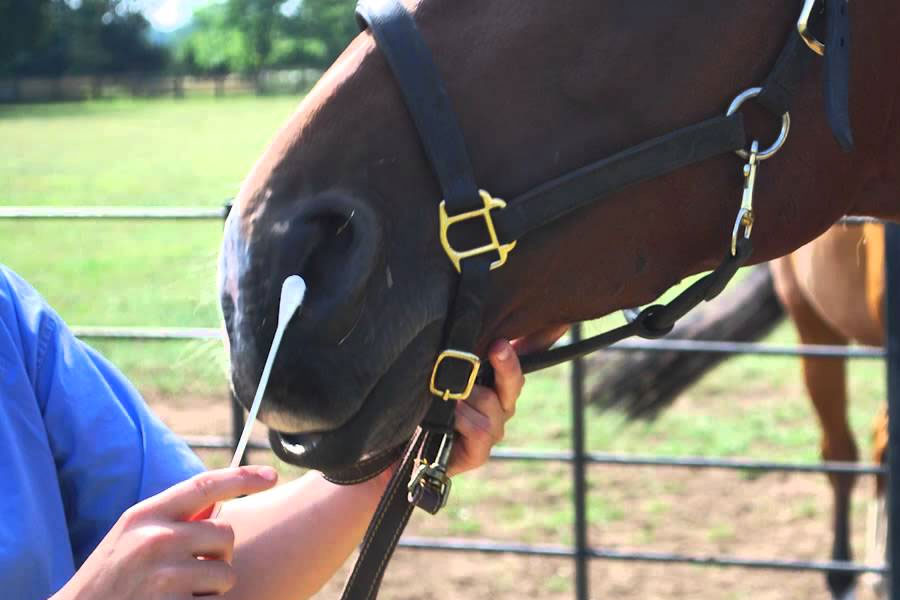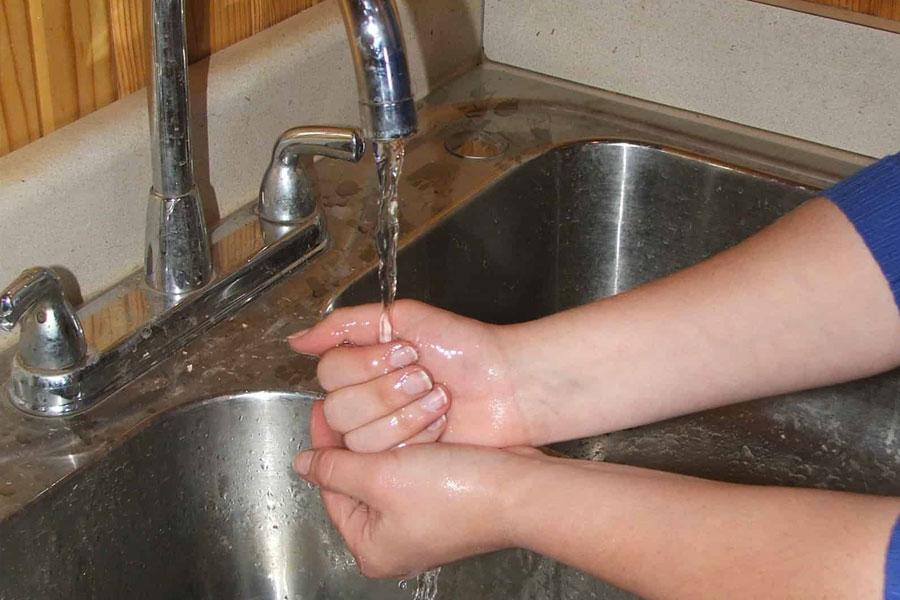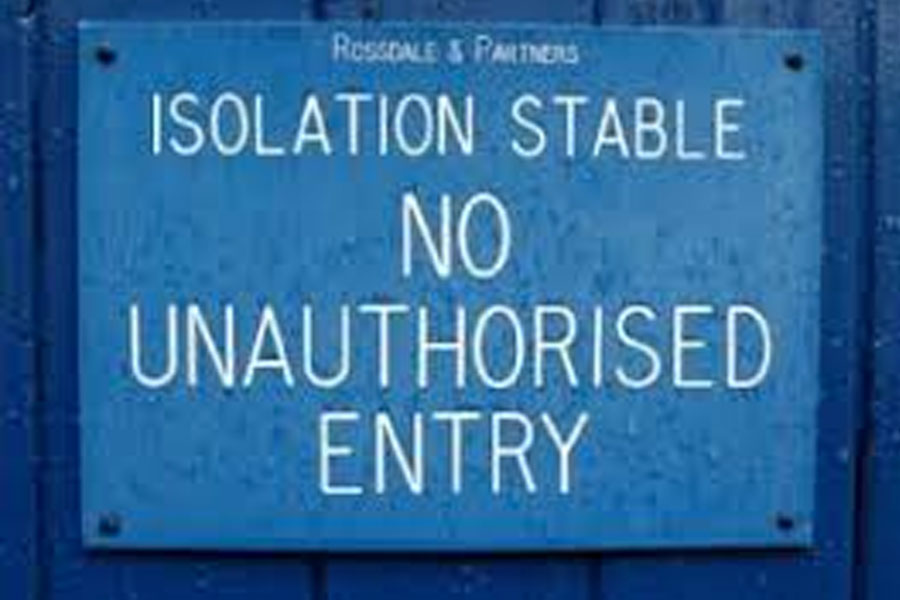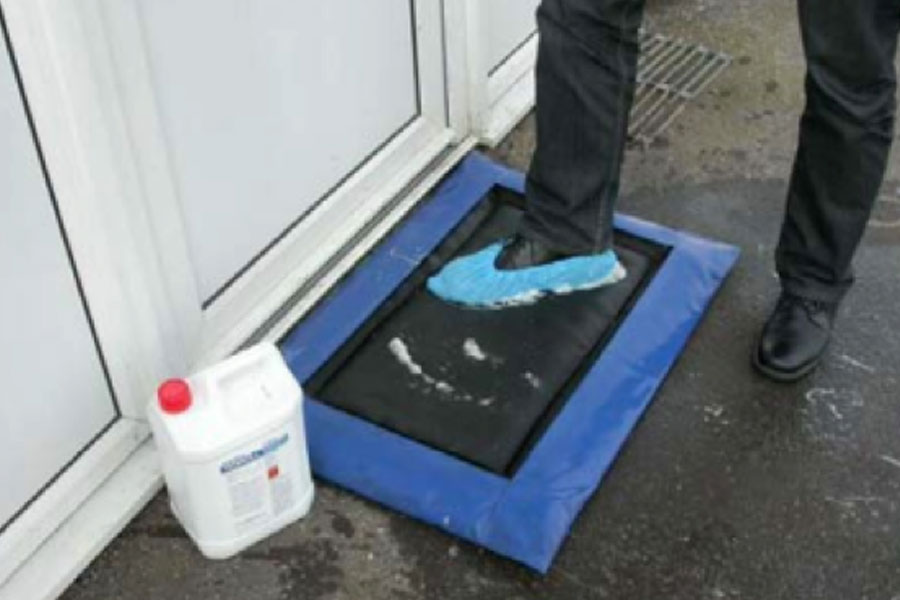Equine Flu ( or equine influenza) is caused by various strains of the influenza virus that affect the upper and lower respiratory tract of horses, donkeys and mules. The virus is similar to the flu virus that affects people, but it is not identical, so horses cannot be infected by human influenza or vice versa.
Once the virus has been inhaled, it invades the lining (epithelium) of the airway, which becomes inflamed, producing a very sore throat and a nasty cough. This damage causes patches of the membranes lining the airways to ulcerate, which disrupts the clearance of mucus and debris from the airways. Bacteria invade these damaged areas leading to further infections.
As with human version, equine flu is very contagious. With an incubation period of one to five days, it spreads rapidly. The disease is spread by the virus being released into the atmosphere by infected animals. It is mainly acquired through inhalation of virus from ill animals coughing and spluttering. Indirect spread is also possible via buckets or grooms/handlers/nurses/vets.
Signs of equine flu
- A very high temperature of 39-41C which lasts for one to three days
- A frequent harsh, dry cough that can last for several weeks
- A clear, watery nasal discharge that may become thick and yellow or green
- Enlarged glands under the lower jaw
- Clear discharge from the eyes and redness around eyes
- Depression and loss of appetite
- Filling of the lower limbs.
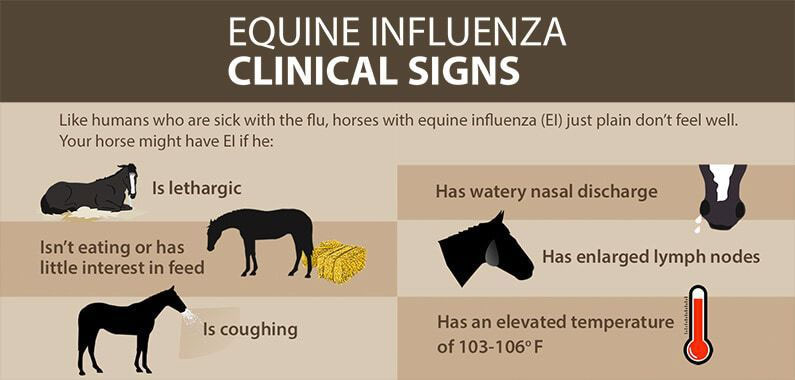
If you suspect your horse has equine influenza, you should contact your vet. As soon as a horse shows any suspect signs, strict hygiene and isolation procedures should be adhered to.
Horses that have been in contact with an affected animal should be carefully monitored and should not attend shows. It is recommended that horses on a stable yard with an outbreak of equine flu do not leave the premises while the outbreak is ongoing.
Diagnosis
An accurate diagnosis of equine flu can be made by:
- recognising the clinical signs and the history of rapid spread between horses
- isolation of the virus through nasal or naso-pharyngeal swabs
- rising antibody levels in blood (serum) samples taken early in the course of the disease and two to three weeks later
- history of recent contact with a confirmed case of the disease
Vaccinated horses may show signs, but these are usually milder than those experienced by unvaccinated horses.
Treatment
Horses with respiratory infections should be given complete rest. Ideally they should not restart any strenuous exercise until two weeks after the signs have gone.
Good stable ventilation and management is essential. Exposure to dust and spores should be minimised, as horses with respiratory infections are more susceptible to airway irritation. It is best to switch to dust-free bedding and feed-soaked hay, or better still haylage and feed this from the floor.
If weather permits, affected horses benefit from being turned out for at least part of the day once their temperatures have returned to normal. This is especially important in the recovery stages.
Antibiotics have no effect against a virus, but can be useful to control secondary bacterial invasion. This is a risk in foals, which can succumb to fatal pneumonia. Medications to help breathing can prove beneficial.
Prevention
Equine flu is difficult to control, especially in horses that are frequently transported and mixed extensively. Outbreaks are most common when young susceptible horses are brought together at sales and shows, or for weaning and training. Vaccination is the preferred method of control and is compulsory when competing under British Horseracing Authority, FEI and affiliated governing bodies’ rules in the UK.
The current vaccination schedule is:
- 1st vaccine
- 2nd vaccine (21-92 days after first)
- 3rd vaccine (150-215 days after second)
To compete, horses require booster vaccinations not more than 365 days from their last vaccination. Horses must not have been vaccinated less than seven days before racing. Horses competing under FEI rules must have received a booster vaccination not more than six months and 21 days prior to competing. If you compete under affiliated rules, please refer to the appropriate rulebook to ensure your horse’s vaccinations comply with their requirements.
If the disease occurs locally, it may be advisable to give a booster vaccination to any horse that has not been vaccinated in the previous six months. Consult your vet for advice.
The 2019 outbreak has been identified as being caused by the Florida Clade 1 virus. It is recommended that horses are vaccinated with either the ProteqFlu and Equilis Prequenza vaccines as both contain Florida Clade 1.
How to reduce the risk of getting flu at your yard
Protocol for new arrivals
Flu often occurs shortly after the arrival of new horses on to a premises and yards should have protocols in place for quarantining new arrivals for a period of time (ideally in isolation facilities for 3 weeks) before mixing them with resident horses. Before arrival, confirm the new horse is vaccinated against flu and discuss other infectious disease screening tests with your vet.
Good general hygiene practices
Wash your hands between handling different horses and use designated equipment for each horse. Events are good places for the circulation of infectious diseases. When away from the yard, take your own equipment, including water buckets and water. Avoid communal areas and contact with other horses. Disinfect all equipment including your trailer, when you arrive back at the yard. Closely monitor your horse too, as movement and mixing with other horses means your horse is at a higher risk of getting an infection, like flu.
Be prepared
Do you have yard facilities if a horse requires isolation? A completely separate stable, ideally 25m from other horses and no shared airspace is needed. You must use separate equipment, handlers (or if this is not possible; protective clothing, gloves, separate boots and care for the isolated horse after all other horses) and muck heap when dealing with a horse in isolation. Temporary isolation can be set up by moving other horses away from the stable area/block and using it just for the isolated horse. Taping off the area and using clear signage makes others aware to avoid the area, with disinfectant foot dip and handwashing at the entrance/exit.
Steps to take if flu is confirmed at your yard
Your vet will advise you on treatment for the horse that has flu. As with human flu, rest, supportive care and anti-inflammatories are usually all that is needed and with time, your horse will feel better. Vaccinated horses that have no signs can still carry and spread the virus, but the amount of virus shed will be at a lower level and for a shorter period of time. These clinically healthy horses should still follow the precautionary measures put in place.
Measures to prevent the spread of flu will be yard specific and tailor-made by your vet, they will include:
- Isolation of infected horses. Infected horses will spread the virus in respiratory droplets, through coughing and can shed the virus for up to 10 days. They must be isolated until your vet advises they are no longer infected.
- All horse movements on and off the yard should be stopped.
- Monitor all horses on the yard for clinical signs and record their rectal temperature daily, it should be less than 38.5˚C (your vet can advise you on how to do this if you are unsure). A rise in temperature can be an early sign of an infection.
- Booster vaccinating all in-contact horses, even if they are not yet due their annual booster, has been shown to provide horses with even more protection against flu.
